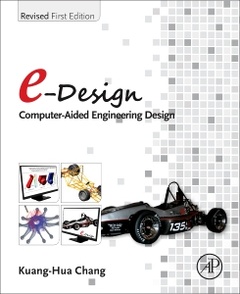e-Design Computer-Aided Engineering Design
Auteur : Chang Kuang-Hua

e-Design: Computer-Aided Engineering Design, Revised First Edition is the first book to integrate a discussion of computer design tools throughout the design process. Through the use of this book, the reader will understand basic design principles and all-digital design paradigms, the CAD/CAE/CAM tools available for various design related tasks, how to put an integrated system together to conduct All-Digital Design (ADD), industrial practices in employing ADD, and tools for product development.
1. Introduction to All-Digital Design 2. Geometric and Solid Modeling3. Mechanical Assembly4. Design Parameterization 5. Product Data Management and Data Exchange6. Kinematic and Dynamic Analyses of Mechanical Systems7. Structural Analysis Using Finite Element Method8. Fatigue and Fracture Analysis9. Failure Probability Estimate10. Reliability-Based Design11. Virtual Manufacturing12. Rapid Prototyping13. Product Cost Estimate14. Design Decision Making15. Design Optimization16. Future Trends in All-Digital Design
Project P1: Solid Modeling, Design Parameterization, and Product Data ExchangeProject P2: Mechanical System Analysis Project P3: Structural FEA and Fatigue AnalysisProject P4: CNC Machining SimulationsProject S1: Solid Modeling, Design Parameterization, and Product Data ExchangeProject S2: Mechanical System AnalysisProject S3: Structural FEA and Fatigue AnalysisProject S4: CNC Machining Simulations
- Comprehensive coverage of essential elements for understanding and practicing the e-Design paradigm in support of product design, including design method and process, and computer based tools and technology
- Part I: Product Design Modeling discusses virtual mockup of the product created in the CAD environment, including not only solid modeling and assembly theories, but also the critical design parameterization that converts the product solid model into parametric representation, enabling the search for better design alternatives
- Part II: Product Performance Evaluation focuses on applying CAE technologies and software tools to support evaluation of product performance, including structural analysis, fatigue and fracture, rigid body kinematics and dynamics, and failure probability prediction and reliability analysis
- Part III: Product Manufacturing and Cost Estimating introduces CAM technology to support manufacturing simulations and process planning, sheet forming simulation, RP technology and computer numerical control (CNC) machining for fast product prototyping, as well as manufacturing cost estimate that can be incorporated into product cost calculations
- Part IV: Design Theory and Methods discusses modern decision-making theory and the application of the theory to engineering design, introduces the mainstream design optimization methods for both single and multi-objectives problems through both batch and interactive design modes, and provides a brief discussion on sensitivity analysis, which is essential for designs using gradient-based approaches
- Tutorial lessons and case studies are offered for readers to gain hands-on experiences in practicing e-Design paradigm using two suites of engineering software: Pro/ENGINEER-based, including Pro/MECHANICA Structure, Pro/ENGINEER Mechanism Design, and Pro/MFG; and SolidWorks-based, including SolidWorks Simulation, SolidWorks Motion, and CAMWorks. Available on the companion
Date de parution : 04-2016
Ouvrage de 1226 p.
19x23.3 cm
Épuisé



